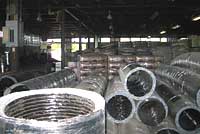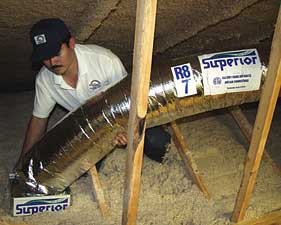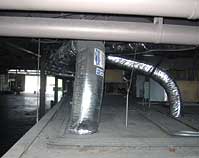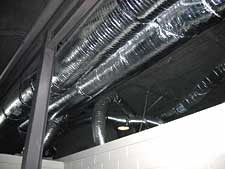
By 1979, Kornbleet founded Payless Insulation, which specialized in servicing existing homes (attics, walls, and floors). The business grew, and in 1986 Kornbleet became a licensed installer of K-13, a cellulose product applied with a spray adhesive. By 1989, Payless Insulation was offering fireproofing and insulation removal services. The company started distributing Bonded Logic's Ultra Touch cotton insulation products in 1999.
Payless Insulation recently started manufacturing patented cotton insulated semi-flex air ducts called Superior Air Ducts. Bonded Logic makes the cotton in these new ducts only for Payless. Kornbleet described the product as a new generation of environmentally friendly, sturdy, higher-efficiency ductwork.

"Contractors often address issues with air conditioning units, but they don't always pay attention to the air distribution system," she said. "Ductwork can be leaky, and return air ducts are the culprits for a horrible amount of heat and dirt being dragged into the system. We want to work with contractors to show them that if they put in a better air distribution system, the units last longer."
It's no wonder that when Kornbleet renovated her new 46,000-square-foot building earlier this year, she couldn't wait to rip out the existing ductwork and install her own Superior Air Ducts.

Lots To Do
The built-up roof building Kornbleet purchased had a 9-foot-high drop-down ceiling, a lot of windows, and little or no insulation. Regular metal ductwork, covered with old duct wrap, ran above the ceiling, with 6-inch flex ducts connecting to the actual registers. The acoustic ceiling did have some insulation pads here and there, but they were falling apart.Only 9,600 square feet of the building were air conditioned, but due to the lack of insulation, over 50 tons of air conditioning was needed for that space. Kornbleet had a moment of panic after purchasing the building, thinking, "It's wonderful to move to this 46,000-square-foot building, but how am I going to afford it? The utility bills in my last building were $1,200, and I thought that was astronomical - and that was only 5,400 square feet."
Kornbleet was also concerned about indoor air quality, and she was determined to remove "every speck" of fiberglass from her building. The first step in the renovation involved insulating the tar and gravel roof, which was transferring a large amount of heat into the building. Between two and three inches of organic K-13 insulation were sprayed on the roof.

Next, the rotten wrap was removed from the hard pipe along with flex duct and fiberglass insulated registers. "The ducts or wrap we removed were black, with mold and mildew everywhere. It was disgusting," said Kornbleet. The metal ducts were cleaned, taped, and sealed. Superior Air Ducts and uninsulated registers were in-stalled, and the metal ducts were sprayed with two inches of Celbar insulation with SK2000 adhesive.
Two additional areas, a 28,500-square-foot built-up roof warehouse and an 8,000-square-foot metal building, did not have insulation or air conditioning, and they were oven-like during the warm months. Kornbleet sprayed the buildings with two inches of K-13, and she indicated the temperatures in the unconditioned spaces are now not more than 5 degrees cooler than it is outside.
Lower Bills
Much of the ductwork runs through spaces that are not air conditioned, but that does not affect system performance, said Kornbleet. "The temperature differential inside the duct does not exceed 1 degree. We have trunk lines that are probably more than 100 feet of 20-inch Superior Air Ducts that deliver the air all the way to the back of the building without losing any kind of temperature and without condensation like fiberglass insulated ducts and wrap."As a result of Kornbleet's efforts, Payless Insulation has been able to reduce its air conditioning load from 50 tons down to 30 tons. Of the seven original A/C units, only four are now needed for the entire facility. The office is comfortable, and the insulated ductwork keeps air noise to a minimum.
Kornbleet is still fine-tuning the building, noting that she expects to remove seven more tons in order to reach the proper temperatures in her building.
The company just moved into the building in April, so Kornbleet said it's too early to see exactly how the new insulation and ductwork will impact utility bills. She does note, though, that her last bill (in June) was only $1,400.
"During the peak summer months, it will probably be more than that, but it's definitely less than what I expected. Most importantly, we got rid of the 1960s musty smell that lingered 24/7."
Publication date: 07/26/2004


Report Abusive Comment